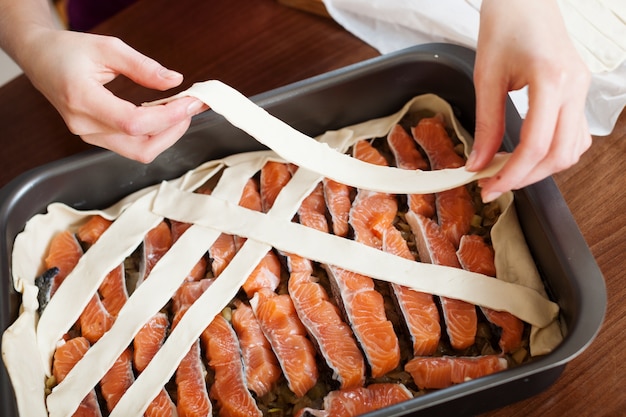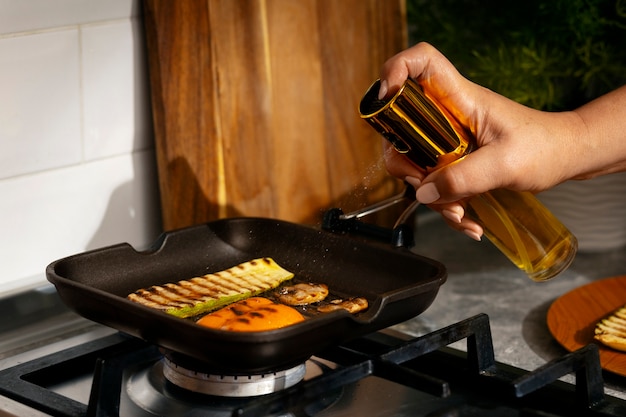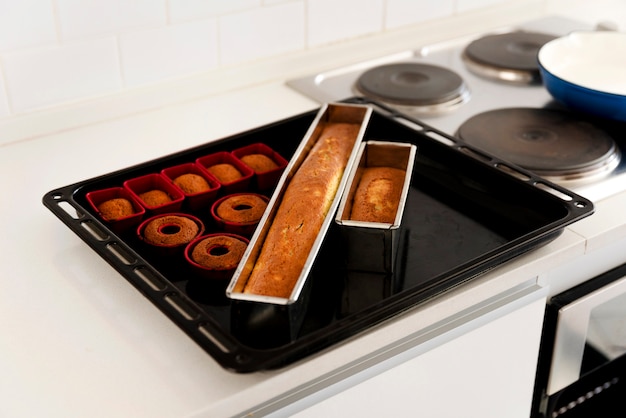There’s a certain satisfaction that comes with grilling a perfect steak. The sizzle, the aroma, the beautiful crust… it's all part of the experience. But not everyone has a grill. And honestly, sometimes, you just crave that steak dinner without the hassle of firing up the backyard beast. So, how do you achieve that restaurant-quality steak right on your stovetop? Fear not, my friend, because I'm here to share all my secrets.
(Part 1) choosing the right cut: The Foundation of a Great Steak

Let's face it, the key to a delicious steak starts with picking the right cut. Now, you've got your ribeyes, your New Yorks, your filets, but for a versatile, flavorful steak that's perfect for the stovetop, I'm a huge fan of strip steak. It’s just got everything going for it.
Why Strip Steak?
Strip steak, also known as new york strip, is a cut from the short loin, a part of the cow that's well-exercised, giving it a great, slightly firm texture. It’s also known for its marbling, those beautiful streaks of fat that contribute to its juiciness and flavor.
Now, there are different grades of strip steak available, like Select, Choice, and Prime, with Prime being the most heavily marbled. For a great stovetop steak, Choice is a good middle ground, offering a nice balance of flavor and tenderness. You can certainly go for Prime if you're feeling fancy, but I find Choice to be a great value for money.
What to Look For
- Marbling: Look for a steak with good, even marbling throughout. This will ensure a juicy, flavorful steak. It's all about that fat, my friend.
- Color: A deep red color is what you want. Avoid steaks that look pale or dull, as they may not be as fresh.
- Texture: The steak should feel firm and springy to the touch. Avoid anything that feels mushy or dry.
- Thickness: Aim for a steak that's about 1-1.5 inches thick. This will allow for a nice sear while still cooking evenly.
- Freshness: If you're unsure about the quality of a steak, ask the butcher to show you a few different cuts before making your choice. Don't be afraid to be picky!
(Part 2) Preparing the Steak: Getting it Ready to Sizzle

You've got your steak, it's looking magnificent. Now it's time to prep it for its starring role on the stovetop. Think of it as prepping your actor for the big scene. It needs to be ready for its close-up!
Pat it Dry
The first step is crucial: patting your steak dry. You want to ensure the surface is completely dry. Moisture will hinder that beautiful sear we're aiming for. I use paper towels, gently pressing them against the steak to absorb any excess moisture.
Seasoning: The Key to Flavor
Here's where the magic happens. The right seasoning can take your steak to the next level. I love a simple salt and pepper combo. I use coarse sea salt for that crunch, and freshly ground black pepper for a bold, peppery kick. But if you're feeling adventurous, you can get creative with other spices. I'm fond of adding a pinch of paprika for a smoky depth or a sprinkle of garlic powder for a pungent aroma.
Remember, the key is to season generously! Don't be shy. Just make sure to evenly distribute the seasoning all over the steak. A little rub, a little sprinkle, and you're good to go!
Let it Rest
Once your steak is seasoned, let it rest for about 30 minutes at room temperature. This allows the steak to come to room temperature, which will help it cook more evenly. It's a simple step but makes a big difference in the final result.
(Part 3) Setting the Stage: Prepping Your Stovetop

Now, the show is about to begin! But before we get to the starring role of the steak, we need to prepare the stage. This is all about the pan and the heat.
Choosing the Right Pan
I'm a big fan of cast iron skillets for this job. They hold heat beautifully and get incredibly hot, which is what you need for that perfect sear. But if you don't have a cast iron pan, a good quality stainless steel skillet will also do the trick. Just make sure it's heavy-bottomed so it doesn't warp when you heat it up.
Getting the Heat Right
Here's the crucial part: the heat. Your pan needs to be screaming hot. We're talking medium-high to high heat. I start by heating my cast iron skillet on the highest setting for about 5 minutes. Then, I crank it down to medium-high heat. The pan needs to be hot enough to sear the steak properly and create that beautiful crust. If the pan isn't hot enough, you'll end up with a steamy, soggy steak instead of a beautifully seared one.
(Part 4) Searing the Steak: Creating That Crispy Crust
Alright, here we are, the moment of truth! This is where you need to pay attention. It's showtime! We're going for that delicious, caramelized crust that will make your mouth water.
Getting the Sizzle
Carefully place your steak in the hot pan. You should hear a satisfying sizzle as it hits the surface. This is the sound of a perfect sear in the making! Don't overcrowd the pan. You want the steak to have room to breathe and get that even sear. If you have a thick steak, you might need to do it in batches.
Resist the Urge
It's tempting, but don't move the steak around for the first few minutes. Let it cook undisturbed on one side. This is how you get that beautiful crust. I usually let it go for about 3-4 minutes. You can check it by gently lifting one corner to see if the bottom has a nice, dark sear. If not, give it another minute.
Flip It Over
Once the bottom is beautifully seared, carefully flip the steak over. Try not to pierce it with your spatula or tongs. You want to keep those precious juices locked inside! Give it another 3-4 minutes on the other side. You can use a meat thermometer to check the internal temperature if you're not sure.
(Part 5) Cooking to Your Desired Doneness: Finding Your Perfect Steak
The level of doneness for your steak is a personal preference. Some folks like their steaks rare, while others prefer them well-done. It’s all about what makes you happy! I'm here to help you navigate the different levels of doneness.
Internal Temperature Guide
A good meat thermometer is your best friend. It's the most accurate way to ensure your steak is cooked to your liking. Here's a handy guide to internal temperatures for different levels of doneness:
| Doneness | Internal Temperature (°F) | Internal Temperature (°C) |
|---|---|---|
| Rare | 125-130 | 52-54 |
| Medium-Rare | 130-135 | 54-57 |
| Medium | 135-140 | 57-60 |
| Medium-Well | 140-145 | 60-63 |
| Well-Done | 145-150 | 63-66 |
Doneness Tips
- Rare: The steak will be red in the center and soft to the touch. This is ideal for steaks with a lot of marbling.
- Medium-Rare: The steak will have a slight pink hue in the center and a bit more resistance. A very popular choice.
- Medium: The steak will have a slight pink hue in the center and be firm to the touch.
- Medium-Well: The steak will be mostly brown in the center, but still slightly pink in the very middle.
- Well-Done: The steak will be completely brown and firm throughout.
(Part 6) Resting the Steak: The Secret to Juiciness
You've seared your steak to perfection, but the journey's not over yet. We need to let it rest. This is a crucial step that many people overlook, but it makes a big difference in the final result. Resting allows the juices to redistribute throughout the steak, ensuring a juicy, tender bite.
Time to Rest
Transfer your steak to a cutting board and cover it loosely with foil. This will keep it warm while it rests. I usually let my steak rest for at least 5 minutes, but 10 minutes is even better. It's tempting to dive right in, but resist the urge. You'll be rewarded with a more tender and flavorful steak.
(Part 7) Slicing and Serving: The Grand Finale
Your steak is beautifully cooked and ready to be enjoyed! Now for the grand finale. Let's slice it up and get ready to feast!
Slicing It Right
Slice your steak against the grain. This means slicing across the muscle fibers, which makes the steak more tender. If you slice with the grain, it will be tough and chewy. You can use a sharp knife or a meat cleaver to slice your steak, whatever you prefer.
Plating It Up
Now, for the fun part! Plate your beautiful steak with your favourite sides. I love serving my steak with mashed potatoes, roasted vegetables, or a simple green salad. And don't forget the sauce! A rich red wine sauce, a creamy béarnaise sauce, or even a simple compound butter can really elevate your steak. You can find lots of recipes online if you want to get creative.
(Part 8) Tips and Tricks: Mastering the Stovetop Steak
Now, I've shared all my secrets, but here are a few extra tips to ensure your steak is absolutely perfect every time.
More Tips for Success
- Don't overcrowd the pan. This will make the steak cook unevenly.
- Don't press down on the steak while it's cooking. This will squeeze out the juices.
- Use a meat thermometer to check the internal temperature. This will ensure your steak is cooked to your desired doneness.
- Experiment with different seasonings and sauces. The possibilities are endless!
- If you're cooking for a crowd, it's helpful to cook the steaks in batches to ensure each one gets a proper sear.
- If you're using a stainless steel pan, be sure to preheat it well and use a little oil to prevent the steak from sticking.
- For a more intense flavor, try searing the steak in a cast iron skillet that has been seasoned with a little bit of butter or olive oil.
(Part 9) FAQs: Common Questions About Stovetop Steak
I'm sure you have a few questions buzzing around your head, so let's address some common queries.
1. What if my steak is too thin?
If your steak is too thin, you can sear it in the pan for a shorter period, around 2-3 minutes per side. You can also finish cooking it in the oven at a low temperature to ensure it cooks evenly. Just place the steak on a baking sheet and bake in a preheated oven at 350°F (175°C) for about 5-10 minutes, or until it reaches your desired doneness.
2. Can I cook my steak in a nonstick pan?
While a nonstick pan can work, it won't get as hot as a cast iron or stainless steel pan, so you might not get the same crispy sear. But if that's all you have, go for it! Just be sure to adjust the cooking time accordingly. You may need to cook the steak for a little longer to achieve that desired crust.
3. How can I tell if my steak is done without a thermometer?
You can use the touch test, but it's not the most accurate method. Gently press on the center of the steak. If it feels firm to the touch, it's medium-well. If it's slightly springy, it's medium. If it feels soft and jiggly, it's rare. But again, a meat thermometer is the most reliable way to ensure your steak is cooked to your liking.
4. What's the best way to store leftover steak?
Refrigerate your leftover steak in an airtight container for up to 3-4 days. You can reheat it in the oven or microwave, but it won't be as tender as when it was freshly cooked. It's best to enjoy your steak fresh!
5. What should I do if my steak is overcooked?
It happens to the best of us! If your steak is overcooked, it's going to be a bit tough and dry. You can try to salvage it by slicing it thinly and using it in a stir-fry or salad. But let's be honest, it's best to try to avoid overcooking your steak in the first place. That's why those internal temperature guidelines are so helpful!
There you have it! My secrets for cooking the perfect strip steak on the stovetop. Go forth and conquer, and don't be afraid to experiment and find what works best for you. Happy cooking!
Everyone is watching

Prime Rib Roast Cooking Time Chart: Per Pound Guide
Cooking TipsPrime rib roast. Just the name conjures images of lavish dinners, crackling fires, and hearty laughter. It’s ...

How Long to Bake Potatoes in the Oven (Perfect Every Time)
Cooking TipsBaked potatoes are a staple in my kitchen. They're incredibly versatile, delicious, and surprisingly easy to m...

Perfect Rice Every Time: The Ultimate Guide to Cooking Rice
Cooking TipsAs a self-proclaimed foodie, I've always been a bit obsessed with rice. It's the foundation of countless cuisi...

The Ultimate Guide to Cooking Asparagus: Tips, Techniques, and Recipes
Cooking TipsAsparagus. The mere mention of this spring delicacy conjures up images of vibrant green spears, crisp and burs...

Ultimate Guide to Cooking the Perfect Thanksgiving Turkey
Cooking TipsThanksgiving. Just the word conjures up images of overflowing tables laden with delicious food, the scent of r...
